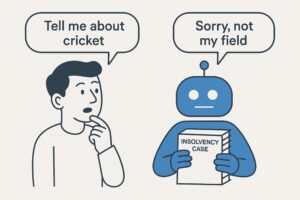The term “chatbot” often conjures images of simple, script-driven tools that manage basic customer service inquiries. However, when it comes to generative AI, such as the sophisticated technology driving VAi, “chatbot” significantly understates its capabilities. This article explores why “chatbot” is a misnomer for generative AI and draws parallels with other historically undervalued descriptors that failed to capture the essence of what they described.
The Limitations of “Chatbot”
- Simple v Complex: Traditional chatbots are typically programmed with pre-defined responses and are capable of handling straightforward, predictable interactions. In contrast, generative AI like VAi operates with a much deeper level of understanding and interaction, processing vast amounts of data to generate responses that are contextually appropriate and highly nuanced.
- Reactive v Proactive: Chatbots react to user inputs without understanding or anticipating user needs beyond the surface level. Generative AI, however, can anticipate questions, offer proactive advice, and evolve based on interaction patterns, making it a dynamic and predictive tool.
- Static v Evolving: Chatbots do not learn from interactions. They operate based on a static set of rules and lack the ability to adapt. Generative AI continuously learns from new data and interactions, improving its accuracy and relevance over time.
Historical Comparisons: When Names Understate Value
Drawing parallels to other instances where terms failed to encapsulate true value or potential can help illustrate the mislabeling of generative AI as merely a “chatbot”:
- “Horseless Carriage” for Cars: Early automobiles were initially referred to as “horseless carriages,” a term that failed to foresee the revolutionary impact of automotive technology on society. It was overly simplistic and rooted in the past, much like the term “chatbot” fails to capture the future-facing capabilities of generative AI.
- “Wireless Telegraph” for Radio: The term “wireless telegraph” didn’t capture the broad potential of radio technology, focusing instead on a single application. Similarly, “chatbot” does not reflect the multifaceted applications and transformative potential of generative AI.
- “Electronic Brain” for Computers: Early computers were sometimes called “electronic brains,” a term that, while evocative, didn’t fully encompass the versatility and future impact of computing technology.
The Need for a New Descriptor
To do justice to the capabilities of generative AI, a new term is necessary that reflects its depth, adaptability, and intelligence. Terms like “AI advisor” or “cognitive engine” suggest a level of sophistication and functionality that “chatbot” lacks, offering a more accurate description of systems like VAi, however the 20 names I got ChatGPT to suggest all lacked the punch I think this technology needs.
Conclusion
The term “chatbot” does a disservice to advanced generative AI systems because the word downplays their sophisticated capabilities. As we continue to integrate AI more deeply into various aspects of our professional and personal lives, adopting terminology that accurately reflects its transformative potential is crucial. And until it gets a better descriptor its roll out will be delayed. Just as the “horseless carriage” became the car, so too must our vocabulary evolve to capture the true essence and impact of generative AI.






